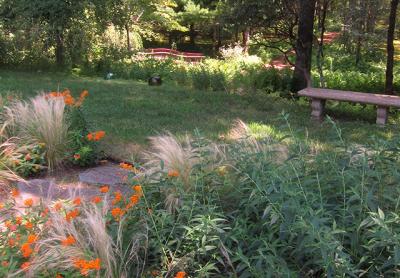Star Gardener: Let Us Now Open Up the View

What’s the point of having the luxury of a long view into the garden if it’s blocked by a conventional flower border?
This conundrum illustrates that the tension between change and tradition, being manifest in all aspects of society, is playing out even in gardening and garden design.
For more than 100 years, the English tradition of outdoor rooms, usually created by interlocking tall hedges hiding secret gardens that slowly reveal themselves and their surprises, has dominated garden design. Through books, magazines, and visits to English gardens, it has influenced the way many of us envision what a “proper garden” is. In recent decades the trend toward naturalistic plantings has gained momentum, perhaps because so much of the natural environment has given way to development, even here on the East End.
Through the work of Piet Oudolf, at Millenium Park in Chicago and the High Line in New York, and other designers, prairie gardens have garnered a steady stream of publicity in the media. A sort of drip, drip, drip of Chinese water torture is finally changing the perception of gardens by a large public, and more of us are ready to put our toes in the water of naturalism, if not towering grasses.
This is a rather long introduction to the story of the flower border on the far side of Vincent Covello and Carol Mandel’s swimming pool in Sag Harbor.
Originally, and for many years, it was a long border of tall perennials, the fourth wall to a garden room enclosing the pool area. The house, with an overhanging porch, parallels the pool and border, with a pool house at one end and dense ornamental trees at the other. Relaxing poolside, the colorful flowers were a distraction and kept out the wider world.
Beyond the flower border the land slopes off into an area filled with tall oaks and masses of mountain laurel. For years Mr. Covello has been developing a dense groundcover of native ferns under the trees, every year breaking up the clumps until ferns now extend nearly as far as the eye can see. Especially when sunlight filters through the tree canopy, the area assumes a fantastical quality that was heightened when a Chinese bridge was added a couple of years ago.
So near, but yet so far. Following the tenets of traditional garden design, the view into the woodland was blocked. To savor its pleasures, you needed to find the path leading out of the pool area to the top of the hill.
For several years now, the Covellos have been experimenting with what we call transparency. It involves pruning trees and shrubs to enable you to see through their trunks to catch glimpses of what lies beyond, while giving greater depth of field to the view. I first came upon the idea of transparency while visiting Le Vasterival, the garden of the late, great, gardener Princess Greta Sturdza, in Normandy.
She died at age 93 some years ago, but she influenced many of the younger gardeners in her area, and one of them illustrated the concept in his garden and passed it along to me on a sunny Saturday in June a few years ago.
Much to my pleasure, the idea resonated with the Covellos. They took it to heart and have run with it. (My last column told how they limbed up the trees n the woodland outside their kitchen window, planting it with large swathes of shade-loving plants to give the feeling of a tumbling golden river.)
It isn’t much of a leap from opening glimpses of a view to opening the entire view. Out went the tall perennials and in their place went Mexican feather grass, its glistening beige blades dancing in the slightest breeze.
Interspersed in the clumps of grass is bright orange butterfly weed, with low-lying orange and pink lantana along the edges of the flower bed.
Now, whether the Covellos are in the pool or relaxing nearby, their eyes stop to digest the bright orange amid the low graceful grasses in the foreground, and then move on into the shaded hillside, with its tall oak trunks anchored by a lush carpet of dark-green ferns.
Think about your own garden. Is there a view that might be opened up to make a refreshing, easy change? Is there an overgrown Kousa dogwood or other tree that is obscuring the rhododendron behind it? Prune the dogwood to reveal its beautiful mottled bark and the tree’s structure. Seeing the rhododendron flowers is a bonus.
In my own garden I’ve pruned the trunks of the clethra near the edge of the garden to give glimpses into the rear. In May, the purple of phlox carpeting the woodland floor carried 100 feet into my garden room and was followed in June by a bright pink mountain laurel along the property line.
Gardens are not stage sets, they are always changing. Open your eyes, and perhaps the view; respect tradition and embrace the new. You and your garden will be the better for it.
